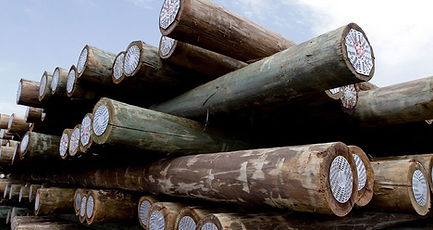Wooden Poles
Treated wooden poles for rural and urban electrification, telephone networks.
Thanks to our different partners in South Africa and around the world, we can produce and supply approximately 50,000 poles of various lengths and diameters per month.
Certificates: ISO 9001:2008, SANS 754: 2010
All our plants are certified to ISO 9001:2008. Copies of the certificates are available on request.



Wind drying of eucalyptus poles
Treatment capacity
Our total capacity from our treatment stations in Kwazulu-Natal in South Africa is about 50,000 poles per month, spread across different sizes.
Our main plant is less than 100 km from Durban harbour, ensuring optimal delivery time and minimal road transport costs and hazards.
Most of our export contracts include transport to the harbour and coordination of sea-freight and road transport to the final destination.
From Mauritania to the Comoros, our poles are installed across the entire African continent.
References:
South Africa
-
TELKOM SA (overhead telephone lines)
-
ESKOM (overhead power lines)
-
Contractors & construction companies for overhead lines
Mozambique
-
EDM (overhead power lines)
-
TDM (overhead telephone lines)
Zimbabwe
-
ZESA (overhead power lines)
-
PTC (overhead telephone lines)
Botswana
-
BPC (overhead power lines)
-
BTC (overhead telephone lines)
Angola
-
Overhead power lines
-
Overhead telephone lines
Kenya
-
KPLC, Overhead power lines
Kuwait
-
Boodai Trading Company (overhead power lines)
West Africa
-
Senegal, Mauritania, Burkina Faso, Ivory Coast, Gambia
Namibia
-
Nampower (overhead power lines)
-
Various electrical contractors
Swaziland
-
Swaziland Electricity Board
-
Swaziland Post and Telecommunications Authority
Malawi , Uganda, Tanzania, Kenya
-
Overhead power lines
-
Overhead telephone lines
Sri Lanka
-
CEB (overhead power lines)
-
Telecoms (overhead telephone lines)
Argentina
-
EDESUR (overhead power lines)
-
Telecoms (overhead telephone lines)
Sudan
-
Power Company (Energy)
Indian Ocean
-
Comores, Mayotte, Madagascar
Technical specifications:
All our poles are treated according and comply with South African Bureau of Standards (SANS) SANS 754:2010 specification. All our plants are in conformity with SANS 754.
Herewith a brief description of the SANS standards:
Origin and species of the trees
Most our wooden poles are currently of South African origin. The most popular species used in South Africa for transmission, telecommunications and agricultural applications are:
-
Grandis (Saligna),
-
Grandis/Saligna Hybrids
For those who require it, we are also able to supply pine poles (from the Northern Hemisphere), for countries that have such requirements.

Eucalyptus forest in South Africa

Pine poles from the north

Aerial view of a treatment plant
Strength
All transmission and telephone poles are tested according to the South African Bureau of Standards (SANS) specification SANS 754:2010 or NF C 67-100 French standards.
Freedom of defects
The maximum permissible defects are also defined by the SANS 745:2010 and include defects such as : sapwood decay, gum veins, gum pockets, insect damage, ring shakes, spirality, spiral grain, post-treatment defects, mechanical damage, crook and sweep and taper.
Preservative treatment
The SANS 745:2010 standard address the following aspects: moisture content, the process, the preservative, retention and penetration of the preservative.
-
The average moisture content may not exceed 25% and no single pole should exceed 28% at the time of treatment.
-
The preservative may be Creosote or CCA that complies with the SANS specifications.
-
Retention requirement is a minimum of 115 kg/m³ for Creosote and 16 kg/m3 for CCA for Eucalyptus species.
-
The minimum depth of solid penetration depends on the hazard class and is 15mm for poles in direct contact with the ground (H4 class).
In practice, the retention and penetration values are considerably higher.
Inspections, methods of testing and marking
These methods and procedure are clearly outlined in the SANS 754:2010. Information such as the treating plant, last two digits of the year, hazard class, strength class, length and size, kiln / air dry and unique pole number indicated on every pole. Additional customized information can also be included in the marking.

